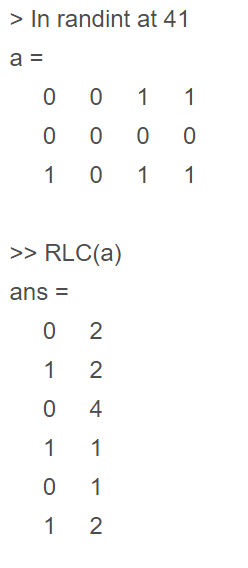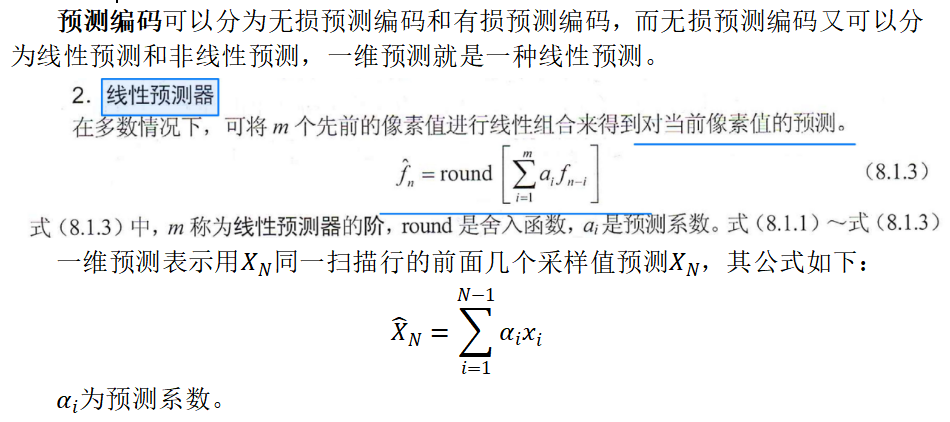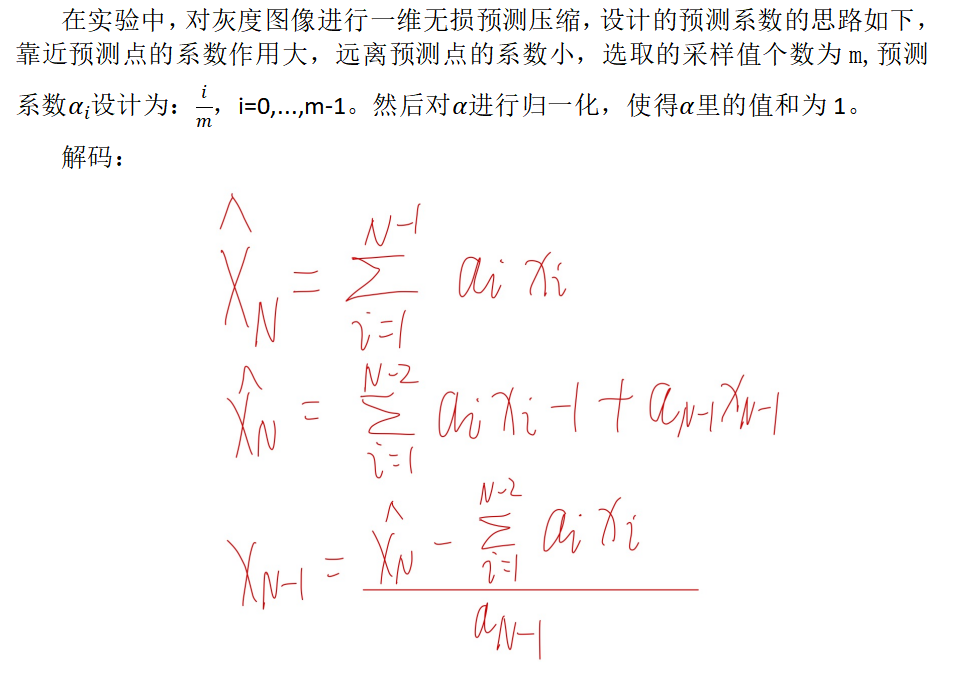游程编码代码
function S=RLC(I)
%======================================================================================================
% 游程长度编码是栅格数据压缩的重要编码方法,它的基本思路是:对于一幅栅格图像,常常有行(或列)方向上相邻的若干点
% 具有相同的属性代码,因而可采取某种方法压缩那些重复的记录内容。其编码方案是,只在各行(或列)数据的代码发生变化
% 时依次记录该代码以及相同代码重复的个数,从而实现数据的压缩。
%------------------------------------------------------------------------------------------------------
% 例如:5555557777733322221111111
% 行程编码为:(5,6)(7,5)(3,3)(2,4)(l,7)。
%===================================================================================================
[m,n]=size(I);
if m~=1&&n~=1
I=I';
I=reshape(I,1,m*n);
end
j=1;
count=1;
% 对第一个到第m*n个进行一般化处理
for i=1:m*n-1
if I(i+1)==I(i)
count=count+1;
else
S(j,1)=I(i);
S(j,2)=count;
j=j+1;
count=1;
end
end
% 最后一个元素处理有两种情况。其一,和前一个元素相等,其二,和前一个元素不等。
% 无论属于哪一种情况都没有在S中记录。
if I(m*n)==I(m*n-1)
S(j,1)=I(i);
S(j,2)=count;
else
S(j,1)=I(m*n);
S(j,2)=1;
end
% I为字符串
% if m==1||n==1
% S(:,1)=S(:,1)-'0';
% S=double(S);
% end
end

一维预测
下面对大小为512*512像素、灰度级为256的标准lena图像进行无损的一阶预测编码,其matlab程序如下:
I=imread(‘LENA.bmp’);
x=double(I);
y=LPCencode(x);
xx=LPCdecode(y);
%显示预测误差值
figure(1);
subplot(121);
imshow(I);
subplot(122);
Imshow(mat2gray(y));
%计算均方差误差,因为是无损编码,那么erms应该为0
e=double(x)-double(xx);
[m, n]=size(e);
erms=sqrt(sum(e(:).^2)/(m*n))
%显示原图直方图
figure(2);
Subplot(121);
[h, f]=hist(x(:));
bar(f, h, ‘k’);
%显示预测误差的直方图
subplot(122);
[h, f]=hist(y(:));
bar(f, h,‘k’);
%编码器
%LPCencode函数用一维无损预测编码压缩图像x,a为预测系数,如果a默认,则默认a=1,就是前值预测。
function y=LPCencode(x, a)
error(nargchk(1, 2, nargin));
if nargin<2
a=1;
end
x=double(x);
[m, n]=size(x);
p=zeros(m, n); %存放预测值
xs=x;
zc=zeros(m, 1);
for i=1:length(a)
xs=[zc xs(:, 1:end-1)];
p=p+a(i)*xs;
end
y=x-round(p);
%解码器
%LPCdecode函数的解码程序,与编码程序用的是同一个预测器
function x=LPCdecode(y, a)
error(nargchk(1, 2, nargin));
if nargin<2
a=1;
end
a=a(end: -1: 1);
[m, n]=size(y);
order=length(a);
a=repmat(a, m, 1);
x=zeros(m, n+order);
for i=1:n
ii=i+order;
x(:, ii)=y(:, i)+round(sum(a(:, order: -1: 1).*x(:, (ii-1): -1:(ii-order)), 2));
end
x=x(:, order+1: end);
一维预测编码+游程编码 python代码

预测系数设计思路 、解码思路

代码
import cv2 as cv
import numpy as np
from matplotlib import pyplot as plt
# 编码器
# LPCencode函数用一维无损预测编码压缩图像x,a为预测系数,如果a默认,则默认a=1,就是前值预测。
def LPCencode(x,m,a):
n=x.shape[0]
p=np.zeros(n) #存放预测值
p[0:m]=x[0:m]
#对后m个点预测
for i in range(m,n):
X=x[i-m:i]
p[i]=np.dot(X,a)
return np.rint(p) #四舍五入
def LPCdecode(y,m,a):
n=y.shape[0]
x=np.zeros(n) #存放灰度值
x[0:m]=y[0:m]
#对后m个点恢复
for i in range(m,n-1):
X=x[i-m:i-1]
p=np.dot(X,a[:m-1])
x[i]=(y[i+1]-p)/a[m-1]
x[n-1]=x[n-2]
return np.rint(x) #四舍五入
def get_mse(records_real, records_predict):
"""
均方误差 估计值与真值 偏差
"""
if len(records_real) == len(records_predict):
return sum([(x - y) ** 2 for x, y in zip(records_real, records_predict)]) / len(records_real)
else:
return None
image = cv.imread('2.jpg')
grayimg = cv.cvtColor(image, cv.COLOR_BGR2GRAY)
cv.imwrite('grayImg2.png', grayimg) #保存灰度图
rows, cols = grayimg.shape
image1 = grayimg.flatten() # 把灰度化后的二维图像降维为一维列表
# print(len(image1))
#设计a a的所有值加起来=1
m = 20
a = []
s = (m - 1) / 2
for i in range(m):
y = i / m / s
a.append(y)
print('a设计完成,和为',sum(a))
print('预测编码')
img_code=LPCencode(image1,m,a)
pre_image = np.reshape(img_code,(rows,cols)) #预测图像
cv.imwrite('pre_image2.png', pre_image) #保存
print('预测解码')
img_decode=LPCdecode(img_code,m,a)
de_image = np.reshape(img_decode,(rows,cols)) #预测图像
cv.imwrite('de_image2.png', de_image) #保存
#计算均方差误差,因为是无损编码,那么erms应该为0
e=image1-img_decode
# print(e)
erms=get_mse(image1,img_decode)
print('均方差误差:',erms)
# 行程压缩编码
data = []
e3 = []
count = 1
for i in range(len(e)-1):
if (count == 1):
e3.append(e[i])
if e[i] == e[i+1]:
count = count + 1
if i == len(e) - 2:
e3.append(e[i])
data.append(count)
else:
data.append(count)
count = 1
if(e[len(e)-1] != e[-1]):
e3.append(e[len(e)-1])
data.append(1)
#计算图像存储空间
size1=rows*cols*8
size2=len(e3)*8
print('压缩前图像存储空间为:',size1,'bit')
print('压缩后图像存储空间为:',size2,'bit')
# 压缩率
ys_rate = (size1-size2)/size1*100
print('压缩率为' + str(ys_rate) + '%')
# 行程编码解码
# rec_e = []
# for i in range(len(data)):
# for j in range(data[i]):
# rec_e.append(e3[i])






















 1万+
1万+











 被折叠的 条评论
为什么被折叠?
被折叠的 条评论
为什么被折叠?








